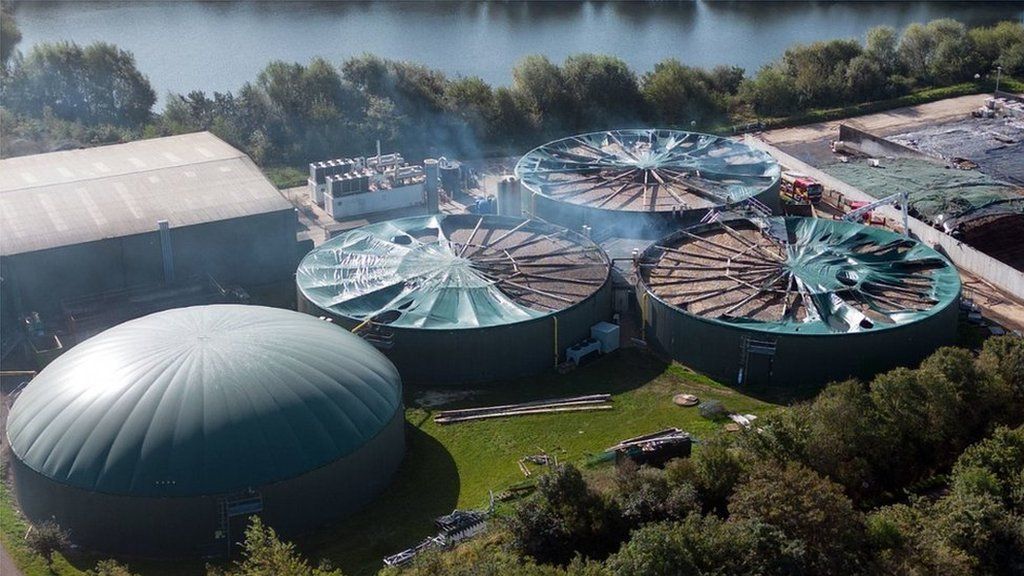Oxfordshire explosion: Plant had permission for lightning mast
Oxfordshire explosion: Plant had permission for lightning mast BBC.com


A food waste recycling plant granted permission for protection mast
By Katharine Da Costa, Reporter, BBC South Today

Severn Trent Green Power site in Cassington, Oxfordshire
Image source: PA Media
A food waste recycling plant that suffered a gas explosion when it was hit by lightning was granted permission for a protection mast in June.
Severn Trent Green Power refused to confirm whether the 22m (72ft) mast had been installed prior to the incident in Oxfordshire on Monday.
The Cassington site was hit multiple times by lightning, causing gases to ignite and explode.
The company said its site operated in line with all industry standards.
It added that it had existing lightning and earthing protection on its biogas tanks.
A Health and Safety Executive spokesperson said it would carry out an on-site inspection at the plant.

Severn Trent Green Power
Image source: Severn Trent Green Power
Severn Trent Green Power received permission from Oxfordshire County Council for a lightning protection mast in June.
As part of its application in February, it said the mast would “reduce the risk of a lightning strike on the digester tanks and infrastructure at the facility”.
“Having lightning protection at anaerobic digestor sites, such as is proposed at the Cassington plant, is considered to be best practice,” it said.
The firm, which says it is the largest producer of renewable energy from food waste in England and Wales, operates 10 other anaerobic digester facilities and five composting sites.
A company spokesperson said following the incident parts of the plant were “up and running again” and that repairs were “largely limited to the tops of three containers is taking place”.
“The site that is built and operated in line with all industry standards, was quickly and safely contained,” they said.
“We will continue to work with the emergency services as we understand more about what happened when the lightning struck.”

Image of the fire
Image source: Jane Grant
Industry body the Anaerobic Digestion Bioresources Association said it intended to “lead a review into whether standards need to be reinforced to deal with the increased frequency of severe weather conditions”.
Oxfordshire Fire and Rescue Service said it was also investigating whether steps could be taken to prevent similar incidents occurring again.
In 2016, a lightning strike ignited methane stored in a waste digester, operated by company Agrivert, at Benson, near Wallingford, causing a fire which burned for 20 minutes and destroyed the roof.
Related Topics
Related Internet Links
SDGs, Targets, and Indicators Analysis
1. Which SDGs are addressed or connected to the issues highlighted in the article?
- SDG 7: Affordable and Clean Energy
- SDG 9: Industry, Innovation, and Infrastructure
- SDG 11: Sustainable Cities and Communities
- SDG 13: Climate Action
The article discusses a food waste recycling plant that suffered a gas explosion due to lightning strikes. This issue is connected to SDG 7 as it relates to the production of renewable energy from food waste. It also relates to SDG 9 as it involves the infrastructure and operation of the recycling plant. Additionally, it is connected to SDG 11 as it pertains to the safety and sustainability of cities and communities. Lastly, it is relevant to SDG 13 as it highlights the impact of severe weather conditions, such as lightning strikes, on climate action efforts.
2. What specific targets under those SDGs can be identified based on the article’s content?
- SDG 7.2: Increase substantially the share of renewable energy in the global energy mix.
- SDG 9.4: Upgrade infrastructure and retrofit industries to make them sustainable.
- SDG 11.5: By 2030, significantly reduce the number of deaths and the number of people affected and substantially decrease the direct economic losses relative to global gross domestic product caused by disasters.
- SDG 13.1: Strengthen resilience and adaptive capacity to climate-related hazards and natural disasters in all countries.
Based on the article’s content, the targets mentioned above can be identified. The focus is on increasing the share of renewable energy, upgrading infrastructure for sustainability, reducing the impact of disasters on lives and economic losses, and strengthening resilience to climate-related hazards.
3. Are there any indicators mentioned or implied in the article that can be used to measure progress towards the identified targets?
Yes, there are indicators mentioned or implied in the article that can be used to measure progress towards the identified targets. These include:
- Percentage of renewable energy in the energy mix
- Number of upgraded and sustainable infrastructure projects
- Number of deaths, injuries, and economic losses caused by disasters
- Level of resilience and adaptive capacity to climate-related hazards
The article mentions the company’s status as the largest producer of renewable energy from food waste in England and Wales, indicating progress towards the target of increasing the share of renewable energy. It also mentions the need to review standards to deal with increased severe weather conditions, implying the need for upgraded and sustainable infrastructure. The incidents of lightning strikes causing explosions highlight the impact on lives and economic losses, which can be measured. Lastly, the focus on preventing similar incidents in the future indicates efforts to strengthen resilience and adaptive capacity.
Table: SDGs, Targets, and Indicators
| SDGs | Targets | Indicators |
|---|---|---|
| SDG 7: Affordable and Clean Energy | 7.2: Increase substantially the share of renewable energy in the global energy mix. | – Percentage of renewable energy in the energy mix |
| SDG 9: Industry, Innovation, and Infrastructure | 9.4: Upgrade infrastructure and retrofit industries to make them sustainable. | – Number of upgraded and sustainable infrastructure projects |
| SDG 11: Sustainable Cities and Communities | 11.5: By 2030, significantly reduce the number of deaths and the number of people affected and substantially decrease the direct economic losses relative to global gross domestic product caused by disasters. | – Number of deaths, injuries, and economic losses caused by disasters |
| SDG 13: Climate Action | 13.1: Strengthen resilience and adaptive capacity to climate-related hazards and natural disasters in all countries. | – Level of resilience and adaptive capacity to climate-related hazards |
Behold! This splendid article springs forth from the wellspring of knowledge, shaped by a wondrous proprietary AI technology that delved into a vast ocean of data, illuminating the path towards the Sustainable Development Goals. Remember that all rights are reserved by SDG Investors LLC, empowering us to champion progress together.
Source: bbc.com

Join us, as fellow seekers of change, on a transformative journey at https://sdgtalks.ai/welcome, where you can become a member and actively contribute to shaping a brighter future.







